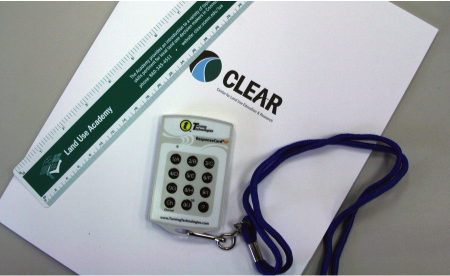By Bruce Hyde
When you say the word “clicker” the first thing many people think of is training a dog. But clickers can also refer to the devices used to engage an audience in group decision-making. When a contestant in a game show decides to “ask the audience,” an audience response system (aka clicker) is used. Recently, clickers have found their way into the educational system at all levels. Universities use them in lectures. In the lower grades, clickers can be used to identify areas where a student is falling behind and in need of remedial help.
UConn CLEAR has been using clickers for over two years as part of the Land Use Academy training with overwhelmingly positive results. They help to avoid “Death by PowerPoint Syndrome” by engaging the audience in the training. Clickers have several advantages over the more traditional way of surveying an audience– posing question and asking people to raise their hand. By pushing a button on the little device in your hand, no one knows how you answered, so the fear of looking stupid is removed. The results are displayed instantly on the screen for everyone to see. This lets the audience compare their answers to the rest of the participants. Questions can have multiple correct answers rather than just one, giving you more flexibility in the design of the questions.
In a presentation, clicker slides can be used to introduce a topic by posing the question at the beginning. This performs two functions: 1) it starts the audience thinking about the subject as it is introduced and 2) it gives the instructor an indication of how much the audience knows about the topic. If the audience is savvy about the topic, the instructor knows to spend less time on it. If the majority of participants get the wrong answer, then more time must be spent reviewing the material.
Clicker questions posed after the introduction of a topic are best put in a form that reinforces the material. For example, following a presentation of information on how to avoid pre-disposition when making land use decisions, a clicker slide with one or more situations can be presented. See the example slide at left. This requires the participant to think about what they have learned and apply that knowledge. Hopefully they will retain the information better than if someone just lectured to them by reading a PowerPoint slide.
Clicker systems can be used to track individual responses, have competitions to see who can answer the fastest and a multitude of other things beyond the basics. To date, we have found no need to use any of these options. Just allowing the audience to participate in the learning experience has been enough.
The cost of the system has dropped dramatically in recent years. A decent system can be purchased for under $1000. As a tool to make learning interesting and fun, it is well worth the investment.

